Delivering successfully as a leader on your change agenda right now is challenging. Against a backdrop that combines unprecedented personal and organizational change.
So how do you set yourself and your team up for success?
We think there are 5 building blocks you should focus on right now.

1. Take an adaptive, systems view on change
The current environment calls for a leadership style that is adaptive – and by that we mean one that requires an understanding of the whole system of change that will impact people and their performance.
Central to this style of managing change is the belief that change success is not only determined by the ability to manage resistance to change, but also the ability to effectively balance people’s capacity for change with the aggregate demands that are placed on them, by multiple projects and initiatives in the organization.
Adaptive leaders ensure that people change planning becomes embedded in wider organizational planning processes. And, just as importantly, become actively involved in developing and agreeing the change plan. Actively devoting their time and energy to supporting it, as well as tailoring it to different groups affected by the change. It is also important to this type of leader that measures of success take account change legacy and adaptability levels that affect how people are able to contribute to future changes.
2. Manage the change load into your teams
People’s capacity for change is not finite. But their ability to commit to projects and initiatives is.
And simply continuing to add new projects and programs into the mix without assessing the potential people-impact it can have on delivery, is a recipe for disaster. Even before COVID-19 our Change Demand Assessment tool consistently indicated there was an issue here, with almost half (49%) of employees indicating that their organization was already overloaded by change and lacked the focus to get business critical changes implemented, as a result of this perpetual change loading.
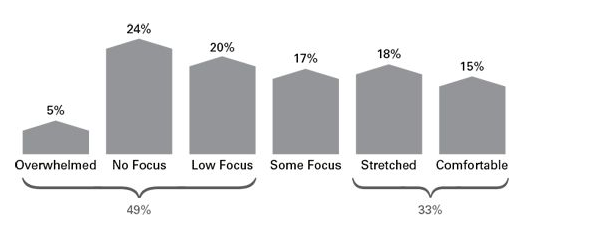 Source Changefirst: Change Demand Assessment tool
Source Changefirst: Change Demand Assessment tool
Today, the sheer level of disruption we face is throwing the regular rhythm of work & BAU into disarray. And this is quickly depleting the capacity organizations need for business-critical and survival type changes to keep moving forward.
More than ever, change leaders who are successful recognize the importance of managing change demand – and the potential for overload – actively, taking a structured, data-driven approach to prioritizing the change load, so as to balance both the needs of the business and peoples’ capacity to deliver against it.
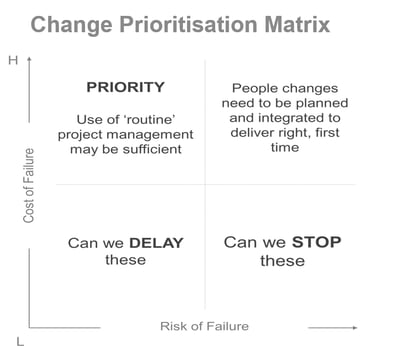
Source Changefirst: Change prioritization matrix
3. Create the network that becomes the engine for change
This is one of the key roles of change leaders - creating the coalition or network of fellow leaders that will help you deliver on your change promises.
The network itself is likely to consist of individuals in several roles - including Change Agents, Reinforcing Sponsors and even informal Influencers - that bring different elements of organizational power, influence and expertise to your project or initiative.
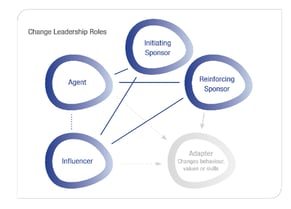
Key to your success is getting this network working in a cohesive way so that, as direction for change is set at a strategic level, it can move through the network into action, ensuring that change is delivered effectively at all levels right across the organization.
Critical Success Factor 2 – Effective Change Leadership - in our PCI ® (People Centred Implementation) methodology enables you to take a structured and data-driven approach to identifying, assessing and developing your change network by Identifying the key individuals and relationships that need to be nurtured, maintained and developed to support your change initiatives.
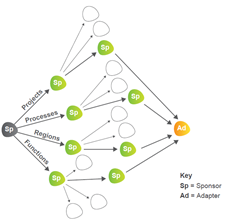
Source Changefirst: Change Network Mapping process
By getting all key stakeholders working in a networked fashion you can ensure that communication is clear and consistent, change decisions are reinforced at all levels and, crucially, there is active role-modelling by change leaders to support and drive change forward.
Checking for performance and behavioral gaps among key stakeholders using digital assessments – like the Sponsor Assessment tool - that can identify possible issues with presence, commitment and levels of support for the change within the change leader network.
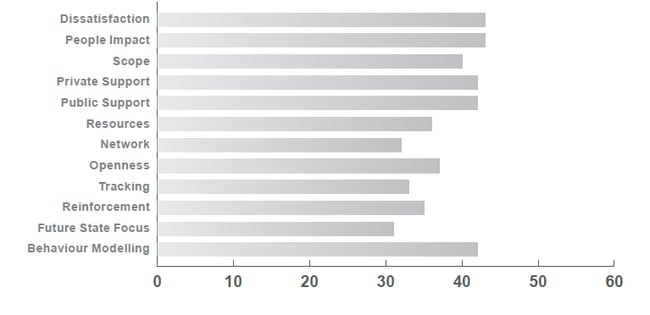
Source Changefirst: Sponsor Assessment Tool
4. Build effective Change Leadership capacity and skills
In disruptive times, every step is the first step. And for many Changefirst clients first steps are small, "sure starts" based around our proven, industry-recognized thinking, and 25 years plus field and academic research, which continues to evolve to be fully fit for today's environment with new and urgent requirement for scale, digital delivery, transferability and role-relevance.
Our dynamic one-day Executive Leader Bootcamp focuses on developing Change Management as a Leadership competency for:
- Senior Executives - continuing to drive transformation and capability building to deliver that transformation in a disrupted environment
- Business Leaders - enabling them to deliver change, alongside having to manage daily business, pivot on local projects and tailoring transformation plans for local deployment
Similarly, role-specific training for Change Agents, local Managers, even individual employees impacted by organizational change, reinforces the importance of a Change Network working in a cohesive way to delivering change across the organization.
5. Equip fellow Change Leaders with the tools they need for success
Finally, you need to give your fellow Change Leaders a number of key tools that are a pre-requisite for success including:
a. Tools: to help build personal and organizational resilience
In times of high disruption like now leaders need to find a way to recalibrate chaotic and disruptive situations. To ensure that they are able to step out with courage and act with conviction. Developing resilience is key to this process.
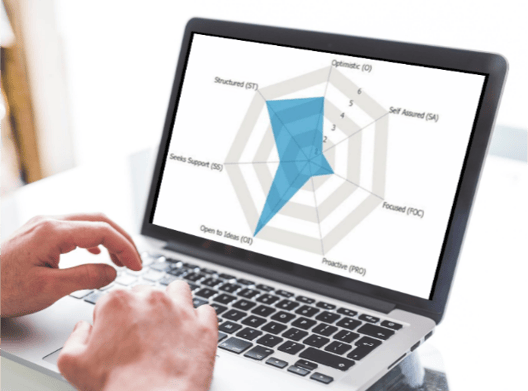
Changefirst: PAI® (Personal Adapability Inventory) methodology
At Changefirst, we see this as a key element of developing an adaptive Change Leadership approach.
And we use our own PAI® (Personal Adaptability Inventory) psychometric and development system, enabling leaders to assess both themselves and their teams using 7 practically identifiable individual characteristics of resilient people – built from our own academic research and client implementation experiences.
b. Tools: to drive agile change planning and collaboration
The combination of the sheer pace and volume of change right now – and the impact of social distancing plus the increasing prevalence of remote working - means that you need to rethink your approach and turn your change planning model on its head.
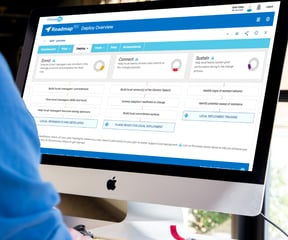
The answer is to give your teams access to digital Change Management platforms – like our own Roadmap Pro® - that not only enables them to plan, implement and track change initiatives in real-time. But can also help you quickly align your Change Management activities with project and program activity in a highly agile way.
c. Tools: to assess and mitigate risk

In an environment where getting Change Management “boots on the ground” is increasingly challenging and sporadic in nature having a Change Management toolkit that enables you to quickly gather, assess and benchmark data is essential to aid decision-making.
In a number of key areas including:
- Change Demand Assessment
- Organizational Capacity Assessment
- Adapter Readiness Assessment
- Change Agent Assessment
- Change Impact Assessment
- Communications Effectiveness Assessment
- Initiative Legacy Assessment
- Initiative Risk Assessment
- Resistance Behavior Assessment
- Resistance Reasons Assessment
- Sponsor Assessment
|
Interested in building effective Change Leadership in your organization? Then contact us for an informal, no-obligation discussion, On how we can apply our globally recognized PCI ® (People Centred Implementation) methodology, digital tools and role-based learning to quickly have an impact on your organization. Simply contact us and one of our Change experts will be in touch to schedule a discussion.
|




Leave a comment